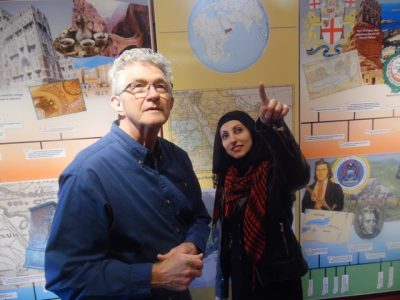Sharing Yemeni history in Coldwater, Michigan
20 April 2017 – Tammy Barnes and Joseph Cialdella

Visitors enjoying the exhibit at Tibbits Opera House. Photo credit: Tammy Barnes.
In 2015, the Tibbits Opera House in Coldwater, Michigan began a two-year project called “Cultural Exchange Coldwater” aimed at sharing the stories and experiences of Arab American residents in this southwest Michigan city. Arab Americans, most of Yemeni heritage, are the largest minority population in this largely white city of 10,000. Yet their voices and perspectives are often marginalized in the area’s social and cultural life.
While it was a challenging undertaking for a small organization, Tibbits decided that following an inclusive and welcoming approach to practicing public history was the only way forward that could help alleviate divisions within the larger community, which grew in part from increasing anti-Arab and anti-Muslim rhetoric in the wake of the 9/11 attacks and more recent events.
Support for the project came from the Michigan Humanities Council, which in 2014 launched a grant-making initiative called “Heritage Grants: Exploring the History of All Michigan’s People.” The goal of the program is to support local historical and cultural organizations in telling the histories of communities that are frequently absent in these institutions. Together, the collection of 54 projects, ranging from oral histories and exhibits to community dialogues and school programs, helps to reveal a more expansive history of Michigan from the Keweenaw Peninsula to Metro Detroit. Among these projects, the Tibbits Opera House initiative was one of the most unexpected and rewarding examples to see unfold from the application stage to the fully developed project.
Formed in 1965, the Tibbits Opera Foundation and Arts Council saved the opera house from demolition. It also transformed the 1882 structure from a single-use performance space into the cultural center of this small community, offering a variety of programs. With its well-established reputation within the city, Tibbits’ staff saw a unique opportunity and responsibility to serve residents of diverse backgrounds while also helping the city’s non-Arab population better understand their fellow residents. The latter role is one more often found at larger history museums in urban centers.
To help achieve these goals, the first phase of Tibbits’ project involved building relationships and trust with the Arab American Society of Coldwater and expanding beyond typical program offerings. To do so effectively, they partnered with the Arab American National Museum (a two-hour drive away in Dearborn, Michigan, the U.S. city with the largest percentage of Arab Americans) to develop presentations, workshops, and exhibits aimed at fostering community conversations. The more than 400 participants, including city officials, health care workers, educators, and service club members, learned about the historical and cultural roots of Yemeni Americans in Coldwater. During school programs, nearly 1,500 students learned about the history of Arab immigrants, about famous Arab Americans, and about food traditions and some basic Arabic phrases. Tibbits organized a local chapter of an award-winning photography program called Sura (an Arabic word for photograph). During the workshop, students learned how to operate and care for a camera, as well as how to compose shots. But the instruction went further, serving as a catalyst for creating a sense of self and identity. As they looked through the camera lens, students developed self-awareness and respect toward others, as well as an idea of how they fit into the broader community.
The second phase of the Tibbits’ project centered on an exhibit that told the story of Yemeni immigration to Coldwater and explored cultural life in the community through objects, images, and oral histories. Tibbits’ staff developed the exhibit for several months with members of the Arab American Society and the local Yemeni community. Located in the entryway and common spaces of Tibbits Opera House, the exhibit greets nearly everyone who visits, including the roughly 5,000 people who attend the venue’s forty annual events.
By fostering community connections, Tibbits uses public history and cultural programming to create opportunities for the authentic voices of Arab Americans to come to the foreground and foster human ties between Coldwater’s communities. Today, with a backdrop of racial inequality and xenophobia affecting the quality of life for so many communities in Michigan and beyond, the work of public historians and cultural institutions in creating space to bring people together is more important than ever.
To learn more, visit http://tibbits.org/support-tibbits/heritage-grant-programs/
~ Tammy Barnes is director of audience outreach at Tibbits Opera House in Coldwater, Michigan. She holds a BA in History from WMU and an MA in History Museum Studies from the Cooperstown Graduate Program.
~ Joseph Cialdella, Ph.D., was the program officer for the Michigan Humanities Council’s Heritage Grants program. He currently manages the Program in Public Scholarship at the University of Michigan.




How many Yemeni-Americans actually live in Coldwater at the present time? The total population of the town is only around 10,000, correct?